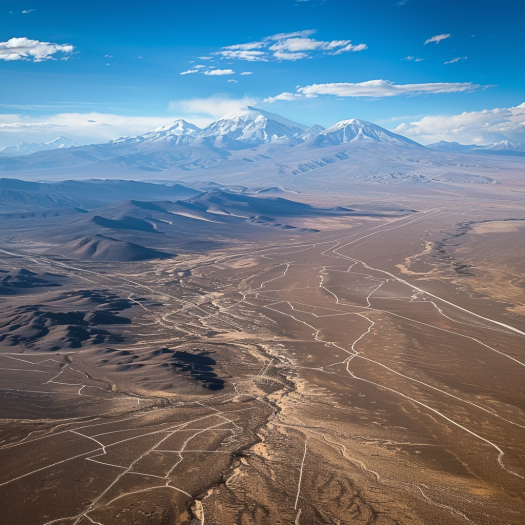Introduction
Stretching across the Bolivian desert, the Sajama Lines are a remarkable network of thousands of near-perfect straight lines etched into the earth. Predating the more famous Nazca Lines and spanning a much larger area, these ancient geoglyphs cover an area of around 22,000 square kilometers, making them one of the largest and most mysterious archaeological features in the world.
The lines were created by the indigenous Aymara people, likely for ceremonial or ritualistic purposes. Despite their vast scale, the precise method and reason for their creation remain unclear. Unlike the Nazca Lines, which depict animals and plants, the Sajama Lines are primarily straight and geometrical, adding to their enigmatic nature.
Historical Background
The Aymara People
- Indigenous Creators: The Sajama Lines were created by the Aymara people, one of the indigenous groups of the Andean region. Their history in the area dates back thousands of years.
- Cultural Significance: The lines are believed to have held ceremonial or ritualistic significance for the Aymara, though the exact purposes remain speculative.
Discovery and Studies
- First Observations: The Sajama Lines were first documented by Western researchers in the early 20th century. Since then, they have intrigued archaeologists and researchers.
- Modern Research: Advanced technologies, such as satellite imagery and aerial photography, have allowed for more detailed mapping and analysis of the lines.
Description of the Lines
Scale and Structure
- Vast Network: The Sajama Lines cover an area of approximately 22,000 square kilometers, far exceeding the area of the Nazca Lines in Peru.
- Geometric Precision: The lines are impressively straight, with some stretching for tens of kilometers without deviating from their course.
Patterns and Orientation
- Linear and Geometric: Unlike the animal and plant motifs of the Nazca Lines, the Sajama Lines are primarily straight lines that crisscross the desert in intricate geometric patterns.
- Possible Alignments: Some researchers suggest that the lines may align with astronomical events or geographical features, though this hypothesis requires further study.
Theories and Interpretations
Ceremonial and Ritualistic Purposes
- Pathways for Pilgrimage: One prevalent theory is that the lines served as pathways for religious pilgrimages, connecting sacred sites such as mountains, springs, and burial grounds.
- Ritualistic Significance: The lines may have been used for processions or other ceremonial activities, playing a role in the spiritual life of the Aymara people.
Astronomical Alignments
- Solar and Lunar Alignments: Some researchers propose that the Sajama Lines might align with the positions of the sun, moon, or stars at specific times of the year, possibly serving as an ancient astronomical calendar.
- Further Evidence Needed: While intriguing, this theory requires more detailed evidence to confirm any direct astronomical connections.
Geographical and Environmental Factors
- Natural Landmarks: The lines may have been drawn to connect natural landmarks or resources, aiding in navigation across the vast desert landscape.
- Environmental Impact: The creation of the lines involved the removal of surface stones to expose lighter soil beneath, a process that has surprisingly minimal environmental impact despite its large scale.
Archaeological and Technological Insights
Methods of Creation
- Simple Tools: The lines were likely created using simple tools to scrape away the dark surface stones, revealing the lighter soil underneath. This method allowed for the creation of extensive and precise lines.
- Labor and Organization: The sheer scale of the Sajama Lines suggests a high level of social organization and labor coordination among the Aymara people.
Modern Technological Studies
- Satellite Imagery: Satellite technology has been instrumental in mapping the extensive network of lines and understanding their full scope.
- Aerial Surveys: Aerial photography provides detailed views of the lines, revealing patterns and connections not easily seen from the ground.
Cultural and Modern Impact
Tourism and Education
- Attracting Visitors: The Sajama Lines attract tourists, archaeologists, and researchers, contributing to the local economy and raising awareness of Bolivia’s rich cultural heritage.
- Educational Value: The lines offer valuable insights into the cultural practices and technological capabilities of the Aymara people, serving as an important educational resource.
Preservation Efforts
- Protecting the Lines: Efforts are being made to protect and preserve the Sajama Lines from damage due to natural erosion and human activity. This includes promoting responsible tourism and conducting ongoing research.
- Cultural Heritage: The lines are an integral part of Bolivia’s cultural heritage, symbolizing the ingenuity and spiritual life of the Aymara people.
Conclusion
The Sajama Lines of Bolivia stand as a testament to the ingenuity and cultural significance of the Aymara people. Spanning an area of 22,000 square kilometers, these ancient geoglyphs continue to fascinate and puzzle researchers, offering a window into the past. Whether created for ceremonial, astronomical, or geographical purposes, the Sajama Lines remain one of the most impressive and mysterious archaeological features in the world.
FAQs
What are the Sajama Lines?
The Sajama Lines are an extensive network of near-perfect straight lines etched into the earth in the Bolivian desert, covering an area of about 22,000 square kilometers.
Who created the Sajama Lines?
The lines were created by the indigenous Aymara people, likely for ceremonial or ritualistic purposes.
How do the Sajama Lines compare to the Nazca Lines?
While the Nazca Lines depict animals and plants, the Sajama Lines are primarily straight and geometric. They also cover a much larger area than the Nazca Lines.
What are some theories about the purpose of the Sajama Lines?
Theories include pathways for religious pilgrimages, astronomical alignments, and connections between natural landmarks.
How were the Sajama Lines created?
The lines were likely created using simple tools to scrape away the dark surface stones, revealing the lighter soil underneath. This method allowed for the creation of extensive and precise lines.
What efforts are being made to preserve the Sajama Lines?
Efforts include promoting responsible tourism, conducting ongoing research, and implementing measures to protect the lines from natural erosion and human activity.

